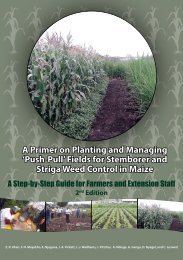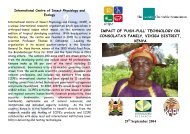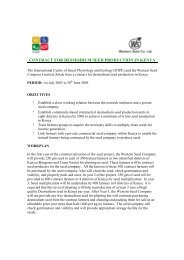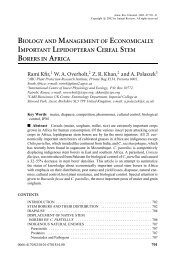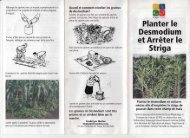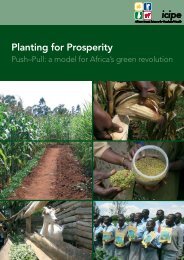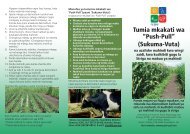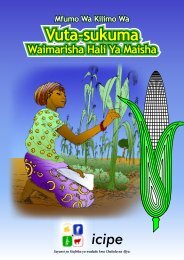The Royal Society Report - Push-Pull
The Royal Society Report - Push-Pull
The Royal Society Report - Push-Pull
Create successful ePaper yourself
Turn your PDF publications into a flip-book with our unique Google optimized e-Paper software.
Table 2.2. Examples of diseases affecting a selection of crops.<br />
Crop Pathogen, disease, bacteria or virus Effect<br />
Apples and<br />
pears<br />
Banana<br />
Fireblight disease (Erwina amylovora)<br />
Black Sigatoka disease<br />
(Mycosphaerella fijiensis)<br />
Panama disease (Fusarium)<br />
Xanthomonas wilt (Xanthomonas<br />
campestris)<br />
Destructive bacterial disease that kills blossoms, shoots, limbs<br />
and sometimes entire trees.<br />
Necessitates weekly sprays with fungicides in major banana<br />
producing areas. Since the major worldwide commercial cultivar<br />
(Cavendish) is susceptible, there is concern that security of<br />
supply may be undermined.<br />
As the disease progresses, younger and younger leaves collapse<br />
until the entire canopy consists of dead or dying leaves.<br />
Pathogen enters the vascular system of the plant, destroying the<br />
fruit bunches and eventually killing the entire plant.<br />
Barley Powdery mildew (Blumeria graminis) Fast evolving and severe constraint on barley production<br />
necessitating regular fungicide applications in northern Europe.<br />
Beans Bacterial blight (several species) Losses occur from death of plants, partial loss of leaves, and<br />
pod-spotting quality factors.<br />
Brassicas Black-rot (Xanthomonas campestris) Seed-borne vascular disease that can cause affected leaves<br />
to drop prematurely and distortion of leaves, dwarfing and<br />
plant death.<br />
Cassava<br />
Citrus fruit<br />
Potato<br />
Rice<br />
Cassava mosaic virus (Geminiviridae<br />
family)<br />
Citrus canker (Xanthomonas<br />
axonopodis)<br />
Potato late blight (Phytophthora<br />
infestans)<br />
Bacterial wilt (Ralstonia solanacearum)<br />
Many fungal diseases (particularly<br />
Magnaporthe grisea)<br />
Plant pathogenic virus that may cause either a mosaic<br />
appearance to plant leaves, or chlorosis, a loss of chlorophyll.<br />
Infection causes lesions on the leaves, stems and fruit of citrus<br />
trees, including lime, oranges and grapefruit. A fruit infected<br />
with canker is safe to eat but too unsightly to be sold.<br />
Causes devastating losses necessitating widespread fungicide<br />
applications.<br />
Very destructive, especially during hot and wet seasons. Plants<br />
wilt and die suddenly.<br />
Despite intensive breeding for resistance, losses are still<br />
considerable in Africa and Asia.<br />
Soya bean Soya bean rust (Phakopsora pakirhizi) Causes a major reduction in yields in Brazil.<br />
Tomato<br />
Wheat<br />
Bacterial speck disease<br />
(Pseudomonas syringae)<br />
Ug99: a race of stem rust caused by<br />
Puccinia graminis (see Case study 3.5)<br />
Cool, moist environmental conditions contribute to the<br />
development of the disease, which has now established itself as<br />
a major production problem in northern USA.<br />
Overcomes previously effective disease resistance genes;<br />
currently affecting yields in Africa.<br />
work, they need food. In developing countries, where<br />
mechanisation may be limited, the energy inputs required<br />
to grow food (from human and animal labour) represent a<br />
significant part of the constraint on production. In the<br />
UK, agriculture uses about 1.5% of UK total energy and<br />
accounts for 0.8% of total carbon emissions (Warwick<br />
HRI 2007).<br />
In addition to CO 2 , the other significant greenhouse gas<br />
associated with crop production is N 2 O, as discussed in<br />
Section 2.6.1. Agriculture accounts for the majority of the<br />
N 2 O emissions in the UK (DEFRA 2009a).<br />
2.9 Maintenance of genetic resources and<br />
germplasm availability<br />
Genetic variation in crops and their relatives is vital for<br />
agricultural development. Many modern varieties have<br />
incorporated traits, for example disease resistance, that<br />
were transferred by conventional breeding using different<br />
varieties, landraces and relatives. However, genetic<br />
uniformity and a narrowing genetic base may lead to<br />
decreased resilience in the face of environmental stress<br />
(as discussed further in Chapter 4) and the potential for<br />
continued novelty and improvements in the future<br />
18 I October 2009 I Reaping the Benefits <strong>The</strong> <strong>Royal</strong> <strong>Society</strong>



